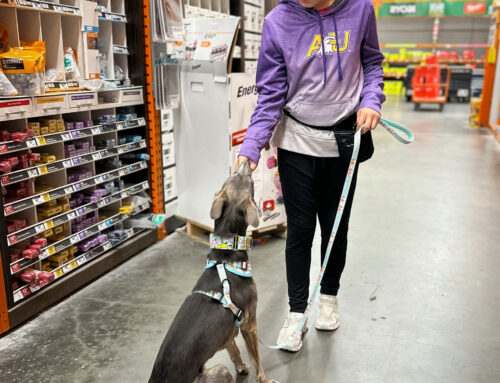Pet therapy sessions at the hospital are a great way to help patients feel happy. Handlers and their dogs make short visits to the rooms of patients to help relieve stress, depression, and anxiety. Pet therapy is known for lifting spirits and lowering blood pressure when patients interact with the dog. Patients and children who engage in pet therapy find it provides a comforting source of healing.
What are Therapy Dogs?
As the name implies, therapy dogs are meant to provide comfort to people who may have physical or emotional needs or just need a boost from a friendly dog. Their intent is to improve the overall quality of life by enhancing a person’s emotional well-being. Different from service dogs, therapy dogs are evaluated and certified enabling them to go with their handler into a variety of settings including medical facilities. Therapy dogs can provide:
- Distraction from procedures or boredom
- Increase comfort and lessen anxiety
- Bring smiles and joy
A team’s presence can lower a patient’s blood pressure, improving their cardiovascular health. Other emotional benefits include increased socialization, lower stress or anxiety, and more engagement, and communication. For instance, if your family member has not been in a hospital for a long time and has become lonely, distant, or barely communicated, a therapy dog can do wonders. Just a quick session can give your relative a boost in their day.
The Role Of Therapy Dogs In Hospitals
For many people, the idea of therapy dogs conjures up images of a friendly dog going from room to room, bringing joy to hospital patients. Therapy dogs that work in hospitals provide what is known as Animal Assisted Therapy (AAT) or Animal Assisted Activities (AAA). AAT is often goal-directed and progress is monitored. AAA provides opportunities for education, recreation, and remembrance.
Examples of patients who could benefit from AAT
- Cancer patients
- Patients in long-term care facilities
- Patients with chronic conditions
- Children
Several studies have reported the benefits of AAT. In a study published in PLoS ONE, researchers assessed the emotional and physical benefits of AAT for pediatric cancer patients. The diagnosis and treatment of pediatric cancer can have a tremendous emotional and physical impact on children and increase their risk of developing mental illness later in life. Caregivers of a sick child also are impacted emotionally and physically.
With AAT, patients in this study experienced many emotional benefits, including reduced stress and anxiety, improved quality of life, improved mood, and improved symptoms of depression. Similarly, the caregivers of children had less anxiety and stress with a visit from a therapy team.
Wrap Up
The most significant risk of having pets in hospitals could be sanitation and safety. Handlers must take serious health measures before being brought into hospitals for sessions. These health measures constitute the following practices:
Every dog must have:
- Annual veterinary wellness exam.
- Rabies vaccine or titers of the appropriate level.
- Yearly negative fecal exam
All these requirements must be met before calling over a therapy dog to conduct a session with any patient. With a certified therapy team, patients can reap many emotional benefits, and they will do wonders for their physical, emotional, and mental well-being.






